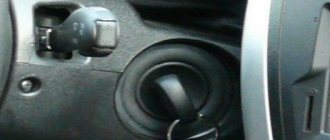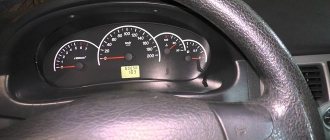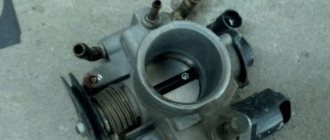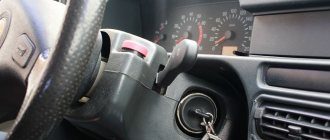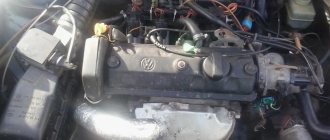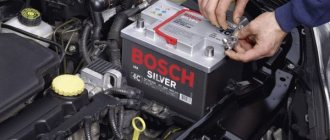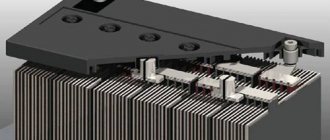The onset of winter cold for many motorists in our country, and not only for the happy owners of products from the domestic automobile industry, is associated with the emergence of a lot of problems of various types. For some, this is the lack of winter tires, a malfunction of the interior heating equipment (stove), and so on.
We will look at the most common malfunction - engine failure to start at temperatures below 10 degrees below zero. There are a great many reasons for this, and we will start with one of the main ones, namely the failure of the fuel injection system to function normally.
Why doesn't the car start if the starter turns but doesn't engage?
Let's look at the reasons why the engine won't start.
What are the solutions and what should a person who finds himself in this situation do? We will talk about Samaras with an injection engine, since there are few carburetor ones left today. If we are talking about the cold season - you did not start in winter, then there are several nuances regarding the engine starting algorithm. Perhaps your candles have flooded or something else. To study this issue more specifically, read the article: How to start a car in cold weather? Where the algorithm is described and, again, possible causes of the malfunction.
Now we will talk more deeply about the technical part, since “winter factors” are no longer needed.
We will describe the problems in the order of the actions taken: that is, starting from the inserted key and ending with the operation of the engine.
About DTOZH
In general, power unit temperature sensors are the most important regulators of an injection engine. There are two of them on it. One is located directly in the cylinder head, it displays the temperature value on the instrument panel.
The second one is located in the thermostat, and provides data on the temperature of the control unit of the power unit. Based on the results obtained, the control unit regulates the fuel supply - it supplies more fuel to a cold internal combustion engine, and less to a hot one. In addition, it is the control unit that regulates the OZ, influences the ignition of the fuel assembly, and activates the coolant fan if the liquid temperature rises above 100 °C.
Obviously, with faulty DTOZh there will be difficulties in the operation of the motor. However, this applies more to the DTOZH, which provides information directly to the block. For example, if the DTOZH is faulty, it will give false values about a cold engine, although it is already boiling. The supply of fuel to the cylinders will increase, because this is provided by the system. Let's say you drove for a long time, then stopped and went into a store. Now starting the power unit will cause obvious displeasure, since it will take a very long time to start due to data failures and oversaturation.
At the same time, the SOP, which is responsible for the ignition of a fuel assembly that is clearly over-enriched, changes greatly. As a result, the fuel will evaporate intensively, and the concentration of gasoline in the fuel assembly will be so high that the mixture will hardly ignite due to the small amount of oxygen.
It was said above that when you press the accelerator pedal, the startup time will be noticeably reduced. Now it becomes clear why this happens. By pressing the gas, we add oxygen to the fuel assembly, and the fuel ignites faster.
Thus, by replacing a faulty DTOZh, you can solve not only the problem with long-term starting of the internal combustion engine, but also other difficulties relating to the process of engine operation and its cooling system. The engine, after replacing the faulty DTOZH, will add stability, throttle response and power.
The starter works, the engine turns, but the car does not start
So, the starter, like the engine, the pistons move, but the engine still won’t start. There is already a problem here, most likely in the fuel-air mixture, perhaps the marks have come off, etc.
Before you sin on this, the first thing you need to pay attention to is the crankshaft sensors:
DPKV - if it malfunctions, it is very difficult to start the engine, and once it is running, it runs unevenly, intermittently, and the power drops noticeably.
Next you should pay attention to the labels:
- Mark on the timing camshaft gear (photo).
- Markings on the flywheel under the thermostat (photo).
If the marks do not match, most likely the belt has simply slipped by one tooth. The camshaft gear itself may be worn. It needs to be adjusted and installed correctly!
Next we will talk about the air-fuel mixture.
I warn you in advance that the easiest way is to do computer diagnostics of the engine or look at the errors on the on-board computer.
The air-fuel mixture is the combination of air, gasoline, and the spark needed to ignite it.
Air supply
As a rule, a malfunction in the air supply should not affect the engine starting problem. At the very least, the engine should still run. Nevertheless, let's not bypass the air system.
The following sensors are responsible for air metering and supply:
- Mass air flow sensor is the most expensive sensor. If it fails, then the car simply begins to consume liters of gasoline, then this sensor can simply die “to zero”, but it indirectly affects the starting of the car. This means, no matter how it fails, the car should start.
- The IAC should not affect the engine starting problem. If it malfunctions, problems arise from idle.
Spark
Here may be the real reasons for our problem:
- First of all, we look at the candles. We turn them inside out (How to remove candles?) and look at their condition. Normal ones should have a slightly brick color, if they are wet, the candles will flood accordingly. It is necessary to clean and bleed the cylinders by idling the engine with the starter with the spark plugs turned out. If one cylinder is flooded, the problem is local (high-voltage wires, faulty spark plug, injector), all cylinders are flooded - a general problem (ignition coil, brains, oxygen sensor, fuel pressure in the rail).
- Next, check for the presence of a spark. To check it, check out the following article: How to check the spark?
- If there is no spark on one cylinder, there is a faulty spark plug or high-voltage wire.
- If it is missing on two adjacent cylinders (1-4 or 2-3), then the problem is in the ignition coil or in the ECU.
- If there is no spark anywhere, the problem may lie in the ignition coil or ECU, in mismatched timing marks, or inoperative DPKV.
- If there are no problems with the presence of a spark, then the cause of the malfunction lies in the fuel supply.
Hard to start when cold
“It doesn’t start well when it’s cold” - such complaints can be heard from men in cold weather, when discussing cars. If the car does not start well when it is cold, then various symptoms and behavior may be described, but the problems due to which this happens are usually almost similar. The prerequisites for a difficult start differ depending on the type of engine: gasoline (injector, carburetor) or diesel. In this article we will look at the most common cases of such problems as:
Troubleshooting Tips
On gasoline engines, a spark plug can be an indicator that it is difficult to start and stalls when cold. We unscrew it, look: it is flooded - it overflows, we look further along the Fri; dry - lean mixture, we also sort out the options. This method of analysis will allow you to start finding out from the more common ones and gradually approach the more complex reasons for the disgusting start of the engine when cold, rather than finding them in the fuel pump, disassembling the injector, climbing into the timing mechanism, opening the cylinder block, etc.
But with a diesel engine, the first on the list of defects will be weak compression. So owners of diesel cars should pay special attention to it specifically. In second place is the quality of the fuel or its inadequacy for the season, and in third place are glow plugs.
Fuel system
If it is below -20 degrees outside the window, it is possible that condensation has formed in the tank. The presence of water in gasoline is a bad sign. Moreover, it is not necessary that it be “diluted” at the gas stations themselves. Due to the temperature difference, condensation forms on the walls of the tank. At low temperatures it freezes. As a result, the VAZ-2115 (injector, 8 valves) does not start. Frozen water can be both in the fuel lines and in the filter itself. There is no point in trying to turn the starter with the hope that the car is about to start. You'll just drain the battery. The only solution to the problem is to warm up the car. It's better if it's in a garage with this problem. By installing an oil or induction heater there, you will quickly warm up the air temperature in the room. And the car will start successfully.
How to start an injection car: popular advice
Ask another motorist with a working car for a light.
Start the injector from a pusher, that is, use a tow or the help of other people.
Try a simple but sometimes helpful method. Turn on the low beam for 20-30 seconds. As a result of this action, certain chemical reactions occur in the battery, and it can provide additional charge to the car starter. We would like to note that this recommendation has not been verified by us and is given in the article from the words of experienced motorists.
Source
Clogged filters
This problem can occur in both summer and winter. And this applies not only to the fuel filter, but also to the air filter. The latter is in a special plastic case. On VAZ 15th model cars it looks like this.
After moving the latches, lift the air filter housing cover and remove the cleaning element itself. If it is dirty, the part needs to be replaced. Filters are consumables and cannot be restored at home. Moreover, they cost pennies. As for the fuel filter, it is located under the bottom of the car. The element looks like in the photo below.
If the car has driven more than 30 thousand kilometers, the filter should be replaced. You will not be able to visually determine the degree of contamination as you can in the air. The part is located in a closed, non-separable case. It has porous paper inside. It is capable of passing particles smaller than 10 microns. Over time, the pores of the paper become clogged, and the filter is not able to pass the required amount of fuel through itself. So that the problem does not take you by surprise, change this part in advance.
A characteristic sign of failure is jerking when moving (as if the fuel supply to the cylinders had stopped for some time). This means that the submersible pump is not able to supply the required amount of fuel through the paper pores. As for the air filter, it is changed every 6 months or every 10 thousand kilometers. By following the regulations, you will protect yourself from such problems.
Attention - air
Finally, another possible reason for sudden movements of the needle is the presence of air bubbles in the antifreeze (“airing” of the system). Since the air and antifreeze have different temperatures, the needle jerks. An indirect sign of this malfunction is the splashing of coolant from the radiator cap or expansion tank, as well as a decrease in the filling volume.
PS In order not to upset Logan drivers, on the Duster and the second generation Logan-Sandero the temperature indicator on the dashboard was completely removed. As they say: no pointer, no problem.
How to solve a problem?
There are two ways to solve this problem:
- On the spot. If you don't have time to remove the spark plugs, you can try drying them directly in the engine. To do this, open the throttle valve 50 percent before starting. Fortunately, on the VAZ-2115 the accelerator pedal is mechanical, with a cable drive. This will allow more air to enter the combustion chamber. The candles are “blown out” automatically. After starting, the throttle valve can be closed. But this method is not always effective. And then the second method comes to the rescue.
- Self-drying. In this case, all four spark plugs are unscrewed. An important point - when removing armor wires, number each of them. Otherwise, the engine will not start at all, since the valve timing will be disrupted. You can quickly dry it with a home hairdryer, setting it to maximum blowing mode. If time permits, you can check the gaps between the electrodes of the spark plugs. When this parameter does not match the factory setting, the spark plug cannot produce a normal spark. We talk about this in more detail.
I have contact
As electricians say, there can only be two faults: there is no contact where needed, or there is contact where it is not needed. This rule also applies in the situation under consideration. The arrow will jump if the joints are oxidized or weakened. Moreover, most often this happens when additional consumers are connected: low beam, headlights, etc.
As mentioned above, the first thing to do when diagnosing DTOZH is to check the contact in the connector. Returning to the previous section, the following should be added: if the sensor malfunctions, the readings fluctuate within the same range, and if they change chaotically, the wiring may be damaged. How important the negative contact is - the mass - will be confirmed by one case described by a forum participant.
The gauge needle sometimes jumped to 130°C. After stopping the engine, it showed the correct result - 90°. The voltage at the battery terminals when the engine was not running was about 12.5 V, and after starting it rose to 13.7.
After a year and a half of unsuccessfully searching for the cause, replacing the battery, alternator and two temperature sensors, I came across one grandpa who installed an additional ground wire from the engine to the body, and the problem was solved.
About spark plug gap
Over time, the gap between the electrodes increases. The normal parameter is from 0.7 mm to one millimeter. You can check this gap using a special feeler gauge.
The same is used for setting valve clearances on carburetor engines. So, if a parameter does not meet the norm, it should be adjusted. To do this, you should use a negative screwdriver. To reduce the gap, press the end of the plug onto the top electrode of the spark plug. With your other hand, hold the part itself. If you “overdid it”, it doesn’t matter – everything can be returned back. To do this, bend the electrode with the edge of a screwdriver (it bends quite easily) and check the distance again. It is worth noting that with a correctly set gap, you can not only ensure trouble-free engine starting, but also reduce fuel consumption by 5 percent. Also the car will run smoothly. After all, the mixture is ignited exactly at the moment when it is necessary. And the last thing is the resource of the candles themselves. If the gap is higher or lower than normal, the risk of breaking through the insulator increases significantly. As for the replacement schedule, it is about 40 thousand kilometers. It is recommended to replace the high-voltage wires along with the spark plugs.
Leaking cylinder head gasket
This problem is one of the rarest causes of engine overheating in VAZ 2114 cars. When it occurs, overheating is a secondary symptom that may be accompanied by a number of others:
- oil leaks from under the cylinder head;
- uneven engine operation and low compression;
- increased oil consumption, noisy engine operation and gas flow, black exhaust.
In this situation, at best, the solution would be to replace the cylinder head gasket. At worst, a major overhaul of the engine with cleaning of all internal cooling channels.
When the engine gets hot, it is dangerous not in itself, but because of its consequences. Long-term driving at elevated operating temperatures first leads to loss of properties of elastic parts: valve stem seals and piston rings. Because of this, oil consumption increases, and engine operation becomes uneven and dirty. All this leads to expensive major repairs.
The consequences of severe overheating are even more severe: the cylinder head and cylinder block are deformed and sometimes crack. An engine that has survived this can no longer be repaired.
Help Friends! car VAZ-2114 1.6 8kl, the problem is that the engine heats up, the fan reaches the red mark and turns on, I wouldn’t pay attention, but it even heats up on the highway if the speed is up to 100 km/h then the temperature stays slightly above 90, and if more than 100 km/h, then the temperature also rises) changing the thermostat did not help). Why does the engine on a VAZ 2114 8-valve injector get hot?
Coil
Modern cars are no longer equipped with distributors. There is an ignition module here. VAZ-2115 (16 valves) is no exception. Sometimes breakdowns happen. Because of this, the VAZ-2115 does not start. The reasons are a faulty ignition distributor.
This item cannot be repaired. And in order not to waste time on diagnostics (or if you don’t have a multimeter), it’s worth installing a known-good ignition module. The VAZ-2115 should start without difficulty. Sometimes the high-voltage wires themselves pierce. But in this case the car starts and starts. This can be heard by the characteristic sound of the engine.
Malfunctions of the car ignition system and other breakdowns
The battery is discharged or faulty. The connection contacts have oxidized. As a result, the starter does not receive enough starting current to crank the engine.
- Spark plugs are flooded.
- One of the three sensors is faulty:
- DPRV (sensor responsible for the position of the camshaft);
- PDZ sensor (throttle position);
- MAF (mass fuel flow sensor).
- The ignition timing is incorrectly set.
- The timing belt or its drive is damaged.
- Problems with oil, there was no change from summer to winter.
- The fuses have blown.
- It breaks through the armored wire.
- And similar problems.
It would take a very long time to list the possible reasons why a practically new car, not to mention used VAZ models. In this case, the solution to the problems that arise is both independent repair within some 10-15 minutes (if you have the appropriate knowledge, experience and spare parts), and rather labor-intensive work. We are not able to provide advice on how to correct each of the cases we have named due to the limited space of our article. But we will still allow ourselves one – a common one.
Winter never comes unexpectedly (we don't mean utility services, for them winter is always news). Thus, in anticipation of the oncoming cold weather, carry out a preventive inspection and, if necessary, repair of your personal vehicle. Replace questionable parts (filters), change the oil, check the injector, and so on.
And then the question of why the VAZ-2115 (or any other make and model) starts poorly or does not start at all, even in mild frost, will be irrelevant for you.
Relays and fuses VAZ-2115
It happens that the car does not start due to a banal failure of the fuses. In this case, the pump will not emit a characteristic hum when the ignition is turned on. The sound should come from under the rear seats. On VAZ-2115 cars the pump is submersible and is located directly in the fuel tank. If there is no hum in the first 3-5 seconds after turning on the ignition, it means that power is not supplied to the element.
We start looking for a break in the fuses. The cover indicates which one is responsible for the electric fuel pump. But not only fuses are checked. The VAZ-2115 is also equipped with a relay. This element should make characteristic clicks when the ignition is turned on. If the VAZ-2115 does not start and clicks are not heard, most likely the pump relay needs to be replaced. Sometimes cleaning contacts helps. For this purpose, special sprays in cans are used. For the future, it is worth purchasing a set of spare relays and fuses. Sometimes such a “childish” breakdown happens on the road. With new parts in stock, you can continue moving without hindrance.
VAZ 2114 does not start well. Main reasons and solutions to the problem
For some reason, it seems that many drivers of this model will be intrigued by the question of why the VAZ 2114 does not start well. Finding the cause of this phenomenon is not as easy as it might seem at first. This is due to certain difficulties in finding defects in this model, because injection systems differ from carburetor systems. The method for determining possible problems will be structured differently, adapting to the design features of the machine.
Malfunction of the VAZ 2114 crankshaft sensor is another reason for poor engine starting
Perhaps this is the only sensor without which a VAZ car will not be able to start at all. If, when cranking the engine with the starter and the ignition and fuel supply are working properly, there is no seizure or ignition of the fuel, then the problem is in the DPKV.. It is better to change it. But there is a test method: checking the crankshaft sensor
. Impact of sensors
Most VAZ-2115 cars operate on the “January 5.1” controller. Crankshaft, temperature and throttle sensors are involved in starting the engine.
DPKV malfunctions usually appear regardless of temperature, but it is worth checking its resistance and comparing it with the data in the calibration table.
A more common malfunction is DT. Remove from position and place in a container with a cooler. We measure the resistance with a multimeter: it should be in the region of 1350 - 1880 Ohms. If there is a temperature indicator, the check can be carried out according to the table. If not, that’s not a failure either, just heat it to a random temperature. As T increases, the resistance decreases. With a one hundred percent warmed up engine it is 87 - 109 Ohms. If the ohms do not change or drop to 0, change the DT.
The throttle assembly is completely disassembled and cleaned. One of the problems is dirt, which expands when heated and interferes with the normal operation of the injection. If the TPS is defective, the car not only does not start when hot, but also “does not drive” (from time to time it stalls and does not start) after warming up.
The TPS is checked with an ohmmeter with the engine running. Place the multimeter on the input and output contacts, ask an assistant to press the gas. The readings should change, and at XX return to the initial ones. If the resistance does not change when you press the pedal or the device indicates infinity, the sensor needs to be replaced. We immediately check the IAC. Usually because of it, the car is unstable at idle or stalls, but starts.
A malfunction of the mass air flow sensor on cars with January 5.1 is recognized by the fact that the car starts when hot and immediately stalls. The sensor comes into operation only after start-up. But on a car with January 7.2, the mass air flow sensor is involved in the start - without it the car will not start.
VAZ 2114 starts poorly - no spark
The ignition module is one of the main problems with the VAZ 2114 injector. It often breaks and sometimes a new one comes with a defect. You can read more about checking the ignition module in other material on our website. Please note that the problem may also lie in the chip that is connected to the module. The presence of power on it must also be checked.
DPCV is another reason why there may be no spark. Since this sensor monitors the phases of cylinder operation, it is one of the main parts of the ignition system. Note that the possibility of its failure is lower than that of the ignition module. It is checked by an electrician on an oscilloscope; garage methods do not provide a clear assessment of the condition of the sensor (only replacement with a guaranteed working one).
ECU. “January” is a relatively reliable injector, but the “brains” can also malfunction at times. Often, a problem with them is identified by a violation of the injection phases: for example, a spark is supplied only to cylinders 2 and 4, or only to cylinders 1 and 3. From time to time, the issue is resolved by simply cleaning the contacts on the ECU chip; it is also subject to oxidation, which becomes a prerequisite for loss signal.
The VAZ 2114 car does not start when hot, but when driving everything is fine
The VAZ 2114 car does not start when it’s hot, but when driving everything is fine. And so you can start it with a push. Who knows where to dig. I also changed the spark plugs and wires. I have a video on my page, check it out.
Ignition problems
Most often, the reason lies precisely in one component of the ignition system. Weaknesses that are the first to come under suspicion are:
- egnition lock;
- induction coils;
- starter and ignition relay;
- lack of voltage at the battery terminals.
Most often, the problem lies in a banal lack of voltage at the ignition switch contacts. It is supplied directly from the battery to the starter.
If, after turning the key, the dashboard goes out or does not light up at all, it may be a problem with the cylinder.
Checking the functionality of the ignition switch is relatively simple:
- it is necessary to dismantle the larva;
- Using a multimeter, the contacts are called in different positions.
If there is no contact, then you should simply purchase a new lock. It simply doesn't make sense to repair it.
You need to pay attention to the behavior of the car immediately after turning the key. If there is no characteristic clicking sound from the side of the door from under the panel, the relay has probably failed. It is located above the clutch pedal.
Like the ignition switch, it simply does not make sense to repair such a relay. You need to purchase a new one and install it in place. You also need to check the ignition coils. Often the spark on the spark plugs disappears due to their failure. The test must be carried out by removing the coil and connecting it to the tester. You should ring the windings - a break in one may be the cause of the malfunction.
The injector does not start well when cold
The first thing you should pay attention to if an injection car is not working well is the sensors. Failure of some of them leads to difficulty starting the engine, since incorrect signals are sent to the ECU. It is usually difficult to start when cold due to:
- The cooling water temperature sensor, DTOZH informs the control unit about the state of the coolant, the indicator data influences the start of the engine (unlike a carburetor car), adjusting the composition of the working consistency;
- Throttle sensor;
- Fuel consumption sensor;
- Mass air flow sensor (or MAP, intake manifold pressure sensor).
If everything is in order with the sensors, you first need to pay attention to the following nodes:
- Often there is a problem with starting when cold due to the fault of the fuel pressure regulator. Well, of course, whether it’s an injector or a carburetor, when a cold car doesn’t start well, if it stalls, the speed jumps, but after warming up everything is fine, then the condition of the spark plugs is strictly checked, and the coils and explosive wires are checked with a multimeter.
- Leaking injectors cause a lot of trouble when it’s hot outside, the car will have difficulty starting on a hot engine, and in the cool season a dripping injector will be a prerequisite for difficult starting in the morning. To test this theory, it’s quite easy to release the pressure from the vehicle in the evening so that there is nothing to drip, and look at the result in the morning.
- We cannot exclude such an obvious problem as air leaks in the power system - it complicates starting a cool engine. Also pay attention to the fuel poured into the tank, as its quality greatly affects the starting of the engine.
On cars such as the Audi 80 (with a mechanical injector), we first check the starting injector.
Tips for starting the engine in cold weather
- Keep the tank full - this way condensation will not form and water will not get into the fuel.
- Turning on the high beams for a couple of seconds before starting will restore some of the battery capacity on frosty days.
- After turning the key in the ignition switch (on an injection car), wait a few seconds until normal pressure is created in the fuel system, and then start the engine.
- Pump up gasoline manually (on a carburetor car), but you must not overdo it, otherwise the spark plugs will flood.
- The car runs on gas, under no circumstances should you start it when it’s cold, first switch to gasoline!
Fuel supply: fuel pump failure and other reasons
If all of the above problems are absent, then you should check the performance of the fuel system. Often the reason lies in the following:
- the fuel pump has failed;
- low pressure level in the fuel line;
- the filter is clogged;
- the injectors are out of order;
- low pressure in the ramp.
You need to remember: it is quite difficult to check the performance of the fuel pump on cars with an injection engine. You can determine its performance by its sound - immediately after turning on the ignition, it should definitely make noise. If the fuel pump is faulty, it will need to be replaced. Such devices do not require repair.
You should check the pressure level in the fuel line and rail. To do this you will need to use a special pressure gauge. The normal pressure level for VAZ 2115 and VAZ 2114 is from 2 to 2.5 atm.
If this indicator is lower than specified, then the car will have poor grip and stall while driving. In this case, it will be difficult to fix the problem yourself. It is worth contacting a car service. It often leaks at the ramp connection point.
When a car has a high mileage and uses relatively low quality fuel, the problem often lies in a clogged filter. It needs to be replaced. The cost of a filter is usually no more than 250-300 rubles. Often the problem is also due to poor quality fuel in the injectors - they are simply clogged. Moreover, in some regions, even branded gas stations sell relatively low quality fuel.
Cleaning them requires special equipment. But often the injectors do not cope with their function due to lack of power. Checking its presence or absence is relatively simple - just disconnect the special connector and use a tester.
As in the case of measuring the voltage on the battery, you need to set the measurement limit to 20 V. The voltage should be 12 V. Lack of power indicates the need to check the wiring for an open circuit.
In some cases, the problem lies in armored wires and candlesticks. It is enough to replace the power cables that supply voltage from the coil to the spark plug - and the motor begins to operate smoothly and unpretentiously.
Difficult to start on cold diesel
As is clear, the start of a diesel engine occurs due to temperature and compression, therefore, if there are no problems with the operation of the battery and starter, there may be 3 main ways to find the reason why a diesel engine does not start well during the day when it is cool:
- Missing compression.
- There is no spark plug glow.
- Fuel supply is missing or disrupted.
One of the reasons that a diesel engine does not start when cold, namely, and the disgusting start of a diesel engine in general, is poor compression. If it doesn’t start in the morning, but seizes from the pushrod, and later blue smoke flows for a certain time, then this is 90% low compression.
Checking engine compression
Checking compression in the engine with a compression gauge and without devices with your own hands. How to measure compression in gasoline and diesel engines. Compression diagnostics. More details
A more common case is when the owner of a car with a diesel engine cannot start a cool engine, but a hot one starts without problems - if there is no glow on the spark plugs. They heat diesel fuel until the diesel reaches one hundred percent operating temperature.
There may be three options why candles do not work:
- The spark plugs themselves are faulty;
- It's the spark plug relay. Its operation is regulated by the coolant temperature sensor. During normal operation, the relay makes quiet clicks when the key is turned in the ignition before starting, and if you cannot hear them, then you should find it in the block and check it;
- Oxidation of the glow plug connector. It is not worth explaining here how oxides affect contact.
3 options for checking glow plugs
To check diesel spark plugs, you can choose several methods:
- Measure their resistance (on the unscrewed spark plug) or the open circuit of the heating circuit with a multimeter (checked in the tweeter mode, both screwed into the engine and unscrewing it);
- Check the speed and degree of heating on the battery by connecting it to ground and the central electrode with wires;
- Without unscrewing it from the motor, connect the central wire to the positive terminal of the battery through a 12-volt light bulb.
If the spark plugs are working, and they are properly supplied with power when the ignition is turned on, then in some cases you need to check the valve clearances. Over time, they get lost, and when the internal combustion engine is cool, they don’t lock up one hundred percent, but if you start it and warm it up, they close up and the engine starts normally when it’s hot.
Faulty diesel injectors, as a result of natural wear or contamination (grayish and other impurities), are a more important nuance. In some cases, the injectors throw a lot of fuel into the return line (you need to do a test) or a dirty fuel filter.
Interruptions in the fuel supply cause even more problems starting the engine. So, if the diesel engine does not start in the morning, regardless of the temperature outside, the diesel fuel is leaving (the return valve does not hold), or it is sucking air, other options are the least possible! Air entering the fuel system can cause the diesel engine to have difficulty starting and stalling.
Fuel is out of season or contains foreign impurities. When it’s cold outside and the diesel engine won’t start or immediately stalls after starting, then there may be a problem with the fuel. DT asks for a seasonal switch to “summer”, “winter” and even “arctic” (for especially cool regions) diesel fuel. Diesel does not start in winter because unprepared summer diesel fuel in the cold is converted into a waxed gel in the fuel tank and fuel lines, and also clogs the fuel filter.
In this case, heating the fuel system and replacing the fuel filter helps start the diesel engine. Frozen water on the filter element poses just as many problems. To prevent the accumulation of water in the fuel system, you can add a little alcohol or a special additive to diesel fuel, called a dehydrator, into the tank.
Tips for diesel car owners:
- If, after pouring boiling water on top of the fuel filter, the car starts and works normally, the diesel fuel is summer.
- If there is low pressure in the fuel rail, the injectors may be leaking and not locking (the operation is checked at a special panel).
- If the check shows that the injectors are pouring into the return line, then the needle in the sprayer does not open (they need to be replaced).
Main reasons:
ReasonsCarburetorInjectorDiesel
| Low fuel quality |
| Poor performance of the fuel pump |
| Clogged fuel filter |
| Weak fuel pressure |
| Low fuel level in the carburetor |
| The pressure regulator in the fuel line is faulty |
| Air leak |
| Poor condition of candles |
| Malfunction of high-voltage wires or ignition coils |
| Dirty throttle valve |
| Idle air valve contaminated |
| Malfunction of air sensor characteristics |
| Engine temperature sensor glitch |
| Valve clearances are knocked down or incorrectly set |
| Incorrectly selected oil viscosity (very thick) |
| Low battery charge |
There are also tasks that occur less frequently, but are more significant. We will also mention them below.
Starter failure
If all other system components are in order, then the reason for the inability to start may lie in the absence of a starter. Typical problems:
- poor contact at the terminals;
- the starter shaft bearing has failed;
- The solenoid relay has stopped working.
It should be noted: the location of the power terminals on the starter suggests the presence of moisture. Therefore, often the contact simply oxidizes, which leads to problems in the operation of the device. That is why you need to carefully examine the contacts. Then clean them and check the voltage. If it is missing, there may be a break in the wiring.
When there is voltage, but the starter does not turn, it is often a problem with the bearings. To replace it, you will need a clean garage, as well as a special puller. This is the only way to dismantle it.
A little more often than a bearing, the solenoid relay fails. Sometimes it just jams - just tap it lightly with the key.
It is very simple to check the functionality of the retractor - just place the starter on the engine block and then touch the contact of the wiring relay connected to the positive terminal. If the starter starts spinning, it means the solenoid relay is in working condition. All of the problems listed above are typical and do not require any major repairs.
The car doesn't start well in cold weather
A picture familiar to many motorists: one fine frosty morning you come to a parking lot or garage. You are trying to make an iron friend, but the attempt ends in failure. As a rule, the reason is that the battery is dead. There are two ways to get out of this unpleasant situation:
To start the car using a “light”, you should connect the negative terminal of your battery to the negative terminal of another car with special wires, and then repeat the same for the positive terminal.
The other car needs to be started and given high speed, about one and a half to two thousand revolutions per minute. Wait two to three minutes to recharge the car.
Next, you need to try to start your car, but you don’t need to turn off the assistant.
We recommend putting wires in the trunk for such a case. If the first attempt fails, then after a couple of minutes you can try again. Do not turn the starter for too long, otherwise you can burn out the starter windings, causing it to break.
How to eliminate the causes of poor starts in winter
The main reason for a poor start in the cold season is a worn-out battery. In a worn-out unit, the starter does not turn the engine after two or three attempts. A high-quality battery will last five to ten or more attempts. If the unit is worn out, it needs to be replaced.
The spark plugs definitely need to be changed. The ideal option is to purchase the part from an imported manufacturer. For example, companies NGK, Denso, etc. Quite often, the problem of cold start is solved by changing the spark plugs.
Problems with the gas pipeline are more complex than those listed above. There may be problems with the fuel filter, injectors on the injection engine, or fuel pump. If the problem is in the injection engine, then the injectors should be washed. This procedure must be carried out in specialized workshops.
Other reasons for the inability to start the engine
Figuring out why the engine stalls is not difficult. In addition to typical problems, the following types of problems may be present:
- timing belt is broken;
- the engine “knocked”;
- the shaft is jammed.
A fairly common problem, especially on 16-valve engines, is a broken timing belt. In this case, the valves on the VAZ 2115 bend. Such breakdowns not only lead to the inability to start the engine. But they require a complete engine overhaul. The situation is similar if the engine knocks. If you can’t start the car even when it’s hot, you should check the air supply channel. Moreover, starting is not always possible the first time.
There are many nuances associated with setting the ignition and ensuring normal engine operation. You will need to carefully understand all the subtleties and nuances. Many problems associated with the inability to start the VAZ 2115 engine are associated with typical malfunctions and repairs take a minimum of time.
Source
Poor starting on a hot VAZ 2114
On a VAZ 2115 it starts perfectly when it’s cool, but when it’s hot when starting it it immediately stalls. Once it cools down, it starts without any problems. What could be the reason?
Poor starting in hot weather is one of the diseases of VAZ cars. Therefore, the question is very common. This happens due to the low quality of spare parts and certain design features. It happens that the fuel pump is replaced with a new one, but it turns out to be faulty. “In search of a malfunction” changes everything in order, and the problem is revealed already on the second round.
If the car does not start when hot, we recommend checking using the following method:
- Point for beginners. Make sure that the problem is related specifically to the “hot” condition of the car. Check the battery charge, make sure that the generator is giving a charge (with a multimeter in voltmeter mode). Are there any problems with the starter? If it sometimes turns, sometimes it doesn’t, or at times it turns poorly, take it to an electrician.
- For everyone else. It’s better to start repairs with diagnostics - it can help save money. Approximately 80% of the circumstances of the problem will be shown by the diagnostician, the faulty part will be replaced, and the car will drive and be fun.
The rest of the information is for the remaining 20% (diagnostics does not reveal problems) and those who do not have trained professionals in the access area.
Separator design
The VAZ 2114 gasoline vapor separator is a small, completely sealed tank made of metal or impact-resistant plastic. It is installed in the right rear part of the car on a special bracket. Using a hose system, it is connected to the gas tank (from where vapors flow through drain pipes) and to a two-way valve. The total volume of this device is 7 liters.
Location of the separator VAZ 2114Once in this tank, the vapors accumulate in it and, due to increased concentration and cooling, condense. Drops of condensation settle on the walls and bottom, after which they gradually flow back into the gas tank. The same vapors that did not have time to condense flow towards the two-way valve. From its name it is easy to guess that it works in both directions at once - “for the intake” of atmospheric air into the tank and “for the release” of fuel vapors outside.
Despite the obvious simplicity of the fuel ventilation system and the minimum of parts located in it, it still breaks down, leading to rather unpleasant consequences.
So, signs of a vapor separator failure may include:
- smell of fuel inside the cabin;
- the smell of fuel near the car (and a lot of time has passed since refueling);
- gasoline stains near the neck of the tank;
- drops of fuel on the ground after a long stay.
Having noticed these signs, we can conclude that the VAZ 2114 gas tank separator is cracked or leaky and is no longer doing its job.
Symptoms
The approximate time that is considered long and for which the engine starts is 5 or 8 seconds. In this case, twitching is definitely observed in the first seconds of operation of the internal combustion engine. At times it seems that the engine is operating on only two cylinders, and not four.
If you press the accelerator before starting, the start will be faster. But at the same time, fuel consumption and engine warm-up time will increase until the speed drops to normal. Another inseparable companion of such a situation is black exhaust.
Obviously, black smoke from the muffler directly indicates that the fuel is not completely consumed and remains in the cylinders.
Causes of overheating, troubleshooting
Why does the VAZ engine get hot? The main reasons are:
- radiator clogged externally or internally;
- a broken or inoperative fan;
- faulty thermostat;
- burnt cylinder head gasket;
- insufficient amount of coolant;
- water pump.
If the engine overheats only when running, it means that an exhaust gas leak has been detected. However, when the engine continues to heat up after stopping, then there is definitely one of the problems listed above. The engine will heat up if you give high speeds, but drive slowly.
Sometimes it is impossible to see and diagnose the presence of air or gases in the system. Then you need to put a bag on the neck of the expansion tank, start the engine, collect the vapors in the bag, and then smell them. If there is a smell of antifreeze, then you need to look at the pump, radiator or thermostat. If the vapors have a gasoline “aroma,” then the cylinder head gasket may be broken.
Removing contaminants
In summer, various pollutants can significantly clog the radiator grille. Naturally, air cooling processes will not be as efficient. As the coolant cools in the radiator, this process also worsens. Preventive action is cleaning the radiator. Paint that peels off honeycombs also causes this effect.
You can rinse the radiator thoroughly at a car wash. The jet from the Karcher sink should not be brought near the radiator honeycombs. Water or other water-based solutions will form scale. When such compounds are oxidized, various impurities appear. Sand and dirt can easily cause the radiator to clog from the inside. What to do? Flush the entire cooling system completely. As a result, we will see cloudy and dirty coolant.
Problems with fan, thermostat, radiator cap
Often problems with the fan can occur if the temperature sensor has failed. The fan motor itself is almost always in working condition. Possible blade damage. Fan failure may be due to a clogged radiator. The bottom of the radiator becomes covered with sediment and dirt.
The temperature sensor is in most cases located at the bottom. The sensor does not warm up well, and as a result the fan does not work (or works, but too late). If there is dirt present, then washing is needed. The temperature sensor wire should be short-circuited. The service fan will start. Sometimes thermostats stick closed as a result of oxidative processes.
As a result, the coolant simply does not flow into the large circuit. Sometimes this can lead to serious problems. But such cases are quite rare. Signs of thermostat malfunctions appear when, when the engine is warm, the heater blows hot and the inlet valve is cold. This means the closed thermostat is stuck. Thermostats need to be replaced occasionally.
If the radiator cap has expired, this may lead to the coolant boiling. This entails low pressure in the system. If the engine operates at normal temperatures when moving, but instantly boils when stopped, then this indicates a faulty cover.
If engines get hot at idle, you need to pay attention to this too.


